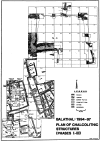Ancient skeletal evidence for leprosy in India (2000 B.C.)
- PMID: 19479078
- PMCID: PMC2682583
- DOI: 10.1371/journal.pone.0005669
Ancient skeletal evidence for leprosy in India (2000 B.C.)
Abstract
Background: Leprosy is a chronic infectious disease caused by Mycobacterium leprae that affects almost 250,000 people worldwide. The timing of first infection, geographic origin, and pattern of transmission of the disease are still under investigation. Comparative genomics research has suggested M. leprae evolved either in East Africa or South Asia during the Late Pleistocene before spreading to Europe and the rest of the World. The earliest widely accepted evidence for leprosy is in Asian texts dated to 600 B.C.
Methodology/principal findings: We report an analysis of pathological conditions in skeletal remains from the second millennium B.C. in India. A middle aged adult male skeleton demonstrates pathological changes in the rhinomaxillary region, degenerative joint disease, infectious involvement of the tibia (periostitis), and injury to the peripheral skeleton. The presence and patterning of lesions was subject to a process of differential diagnosis for leprosy including treponemal disease, leishmaniasis, tuberculosis, osteomyelitis, and non-specific infection.
Conclusions/significance: Results indicate that lepromatous leprosy was present in India by 2000 B.C. This evidence represents the oldest documented skeletal evidence for the disease. Our results indicate that Vedic burial traditions in cases of leprosy were present in northwest India prior to the first millennium B.C. Our results also support translations of early Vedic scriptures as the first textual reference to leprosy. The presence of leprosy in skeletal material dated to the post-urban phase of the Indus Age suggests that if M. leprae evolved in Africa, the disease migrated to India before the Late Holocene, possibly during the third millennium B.C. at a time when there was substantial interaction among the Indus Civilization, Mesopotamia, and Egypt. This evidence should be impetus to look for additional skeletal and molecular evidence of leprosy in India and Africa to confirm the African origin of the disease.
Conflict of interest statement
Figures





References
-
- WHO. Global Leprosy Situation, beginning of 2008. Weekly Epidemiological Record. 2008;83:293–300. - PubMed
-
- Hutchinson J. On Leprosy and Fish Eating: a statement of facts and an explanation. London: Constable; 1906.
-
- Hulse EV. Leprosy and Ancient Egypt. Lancet. 1972;2:1024. - PubMed
-
- Bloomfield M. Hymns of the Atharva Veda. Whitefish, MT: Kessinger Publishing; 2004.
-
- Auferheide AC, Rodriguez-Martin C. Cambridge Encyclopedia of Human Paleopathology. Cambridge: Cambridge University Press; 1998.
Publication types
MeSH terms
Grants and funding
LinkOut - more resources
Full Text Sources
Medical

